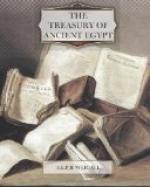“O, brother, husband, friend,” she says, “thy desire to drink and to eat hath not ceased. Therefore be drunken, enjoy the love of women—make holiday. Follow thy desire by night and by day. Put not care within thy heart. Lo! are not these the years of thy life upon earth? For as for the Underworld, it is a land of slumber and heavy darkness, a resting-place for those who have passed within it. Each sleepeth there in his own form, they never awake to see their fellows, they behold not their fathers nor their mothers, their heart is careless of their wives and children.”
She knows that she will be too deeply steeped in the stupor of the Underworld to remember her husband, and unselfishly she urges him to continue to be happy after the manner of his nation. Then, in a passage which rings down the years in its terrible beauty, she tells of her utter despair, lying in the gloomy Underworld, suffocated with the mummy bandages, and craving for the light, the laughter, and the coolness of the day.
“The water of life,” she cries, “with which every mouth is moistened, is corruption to me, the water that is by me corrupteth me. I know not what to do since I came into this valley. Give me running water, say to me, ’Water shall not cease to be brought to thee.’ Turn my face to the north wind upon the edge of the water. Verily thus shall my heart be cooled and refreshed from its pain.”
It is, however, the glory of life, rather than the horror of death, which is the dominant note in the inscriptions and reliefs. The scenes in the tomb decorations seem to cry out for very joy. The artist has imprisoned in his representations as much sheer happiness as was ever infused into cold stone. One sees there the gazelle leaping over the hills as the sun rises, the birds flapping their wings and singing, the wild duck rising from the marshes, and the butterflies flashing overhead. The fundamental joy of living—that gaiety of life which the human being may feel in common with the animals—is shown in these scenes as clearly as is the merriment in the representations of feasts and dancing. In these paintings and reliefs one finds an exact illustration to the joyful exhortation of the Psalmist as he cries, “Let the heavens rejoice, and let the earth be glad; ... let the fields be joyful, and all that is therein.” In a land where, to quote one of their own poems, “the tanks are full of water and the earth overflows with love,” where “the cool north wind” blows merrily over the fields, and the sun never ceases to shine, it would be a remarkable phenomenon if the ancient Egyptians had not developed the sanguine temperament. The foregoing pages have shown them at their feasts, in their daily occupations, and in their sports, and the reader will find that it is not difficult to describe them, in the borrowed words of the old geographer, as a people always gay and often frivolous, and never-ceasingly “fond of dancing and red wine.”




